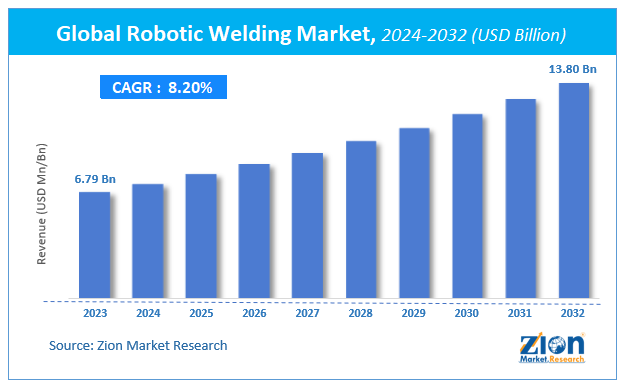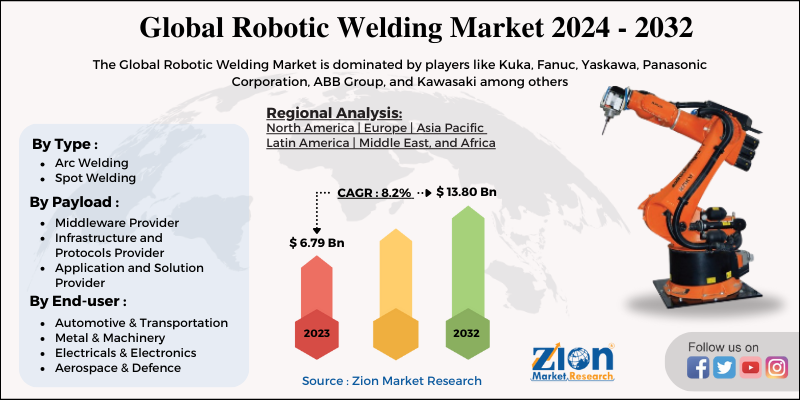Robotic Welding Market Size, Share, Trends, Growth 2032

Robotic Welding Market By Type (Arc Welding and Spot Welding), By Payload (Middleware Provider, Infrastructure and Protocols Provider, and Application and Solution Provider), By End-user (Automotive & Transportation, Metal & Machinery, Electricals & Electronics, and Aerospace & Defence): Global Industry Perspective, Comprehensive Analysis and Forecast, 2024 - 2032-
| Market Size in 2023 | Market Forecast in 2032 | CAGR (in %) | Base Year |
|---|---|---|---|
| USD 6.79 Billion | USD 13.80 Billion | 8.2% | 2023 |
Robotic Welding Market Insights
According to a report from Zion Market Research, the global Robotic Welding Market was valued at USD 6.79 Billion in 2023 and is projected to hit USD 13.80 Billion by 2032, with a compound annual growth rate (CAGR) of 8.2% during the forecast period 2024-2032.
This report explores market strengths, weakness, opportunities, and threats. It also provides valuable insights into the market's growth drivers, challenges, and the future prospects that may emerge in the Robotic Welding industry over the next decade.
Global Robotic Welding Market: Overview
Robotic welding is the mechanism by which welding is conducted using computer programmable devices such as robots. The robotic welding process is primarily used for spot welding as well as arc welding in industries, in particular in the automotive industry. Implementation of the industry 4.0 revolution is a key factor to drive the growth of the robotic welding market.
Global Robotic Welding Market: Growth Factors
Huge acceptance of industry 4.0 revolutions, along with the rising need for scalability in production units in developed economies to satisfy the growing demand for different goods are major factors driving the growth of the global market. However, high capital investment for small manufacturing units especially for the units in developed countries is a major factor that may restrain the growth of the target industry in the near future.
In addition to this stringent government regulations, lack of expertise, and issues related to security are major factors to hamper the growth of the global market in the near future. Nevertheless, technological advancements and the use of collaborative robots may create huge growth opportunities in the future.
Global Robotic Welding Market: Segmentation
The robotic welding market is segmented based on type, payload, and end user.
Based on type the market is divided into arc welding and spot welding. The spot welding segment is projected to grow at a significant rate over the forecast period, due to its numerous advantages including cycle times are fast, efficient utilization of space, and simple operation processes.
By payload, the global market is segregated as a middleware provider, infrastructure and protocols provider, and application and solution provider.
On the basis of application, the global market is divided into automotive & transportation, metal & machinery, electrical & electronics, and aerospace & defense.
Robotic Welding Market: Report Scope
| Report Attributes | Report Details |
|---|---|
| Report Name | Robotic Welding Market |
| Market Size in 2023 | USD 6.79 Billion |
| Market Forecast in 2032 | USD 13.80 Billion |
| Growth Rate | CAGR of 8.2% |
| Number of Pages | 110 |
| Key Companies Covered | Kuka, Fanuc, Yaskawa, Panasonic Corporation, ABB Group, and Kawasaki among others |
| Segments Covered | By Type, By Payload, By End User And By Region |
| Regions Covered | North America, Europe, Asia Pacific (APAC), Latin America, Middle East, and Africa (MEA) |
| Base Year | 2023 |
| Historical Year | 2018 to 2022 |
| Forecast Year | 2024 - 2032 |
| Customization Scope | Avail customized purchase options to meet your exact research needs. Request For Customization |
Global Robotic Welding Market: Regional Analysis
The Asia Pacific robotic welding market is projected to hold a significant share globally in the future, owing to the presence of major players, and increasing acceptance of automation by the countries of Asia Pacific. Further, increasing research & development activities are expected to fuel the growth of the market in the Asia Pacific. The Europe robotic welding market is anticipated to grow at a rapid rate in the years ahead. This is due to growth in industries in the countries of the region.
Global Robotic Welding Market: Competitive Players
Some main participants in the robotic welding market are
- Kuka
- Fanuc
- Yaskawa
- Panasonic Corporation
- ABB Group
- Kawasaki among others
The global robotic welding market is segmented as follows:
By Type
- Arc Welding
- Spot Welding
By Payload
- Middleware Provider
- Infrastructure and Protocols Provider
- Application and Solution Provider
By End-user
- Automotive & Transportation
- Metal & Machinery
- Electricals & Electronics
- Aerospace & Defence
Robotic Welding Market: Regional Segment Analysis
- North America
- The U.S.
- Canada
- Europe
- France
- The UK
- Spain
- Germany
- Italy
- Rest of Europe
- Asia Pacific
- China
- Japan
- India
- South Korea
- Southeast Asia
- Rest of Asia Pacific
- Latin America
- Brazil
- Mexico
- Rest of Latin America
- Middle East & Africa
- GCC
- South Africa
- Rest of The Middle East & Africa
Table Of Content
Methodology
FrequentlyAsked Questions
Robotic welding is an automated procedure that combines the ability to weld metals and other materials using robotic arms fitted with welding instruments. This technology's efficiency, accuracy, and capacity to create high-quality welds make it widely employed in the fabrication and manufacturing sectors.
The need for robotic welding systems is being driven by industries adopting automation to increase productivity, lower labour costs, and minimise human error.
According to a report from Zion Market Research, the global Robotic Welding Market was valued at USD 6.79 Billion in 2023 and is projected to hit USD 13.80 Billion by 2032.
According to a report from Zion Market Research, the global Robotic Welding Market a compound annual growth rate (CAGR) of 8.2% during the forecast period 2024-2032.
The Asia Pacific robotic welding market is projected to hold a significant share globally in the future, owing to the presence of major players, and increasing acceptance of automation by the countries of Asia Pacific. Further, increasing research & development activities are expected to fuel the growth of the market in the Asia Pacific.
Some main participants in the robotic welding market are Kuka, Fanuc, Yaskawa, Panasonic Corporation, ABB Group, and Kawasaki among others. Major players in the global market are focusing on strengthening their position in the target industry by applying various business strategies.
RelatedNews
HappyClients
Zion Market Research
Tel: +1 (302) 444-0166
USA/Canada Toll Free No.+1 (855) 465-4651
3rd Floor,
Mrunal Paradise, Opp Maharaja Hotel,
Pimple Gurav, Pune 411061,
Maharashtra, India
Phone No +91 7768 006 007, +91 7768 006 008
US OFFICE NO +1 (302) 444-0166
US/CAN TOLL FREE +1 (855) 465-4651
Email: sales@zionmarketresearch.com
We have secured system to process your transaction.
Our support available to help you 24 hours a day, five days a week.
Monday - Friday: 9AM - 6PM
Saturday - Sunday: Closed






